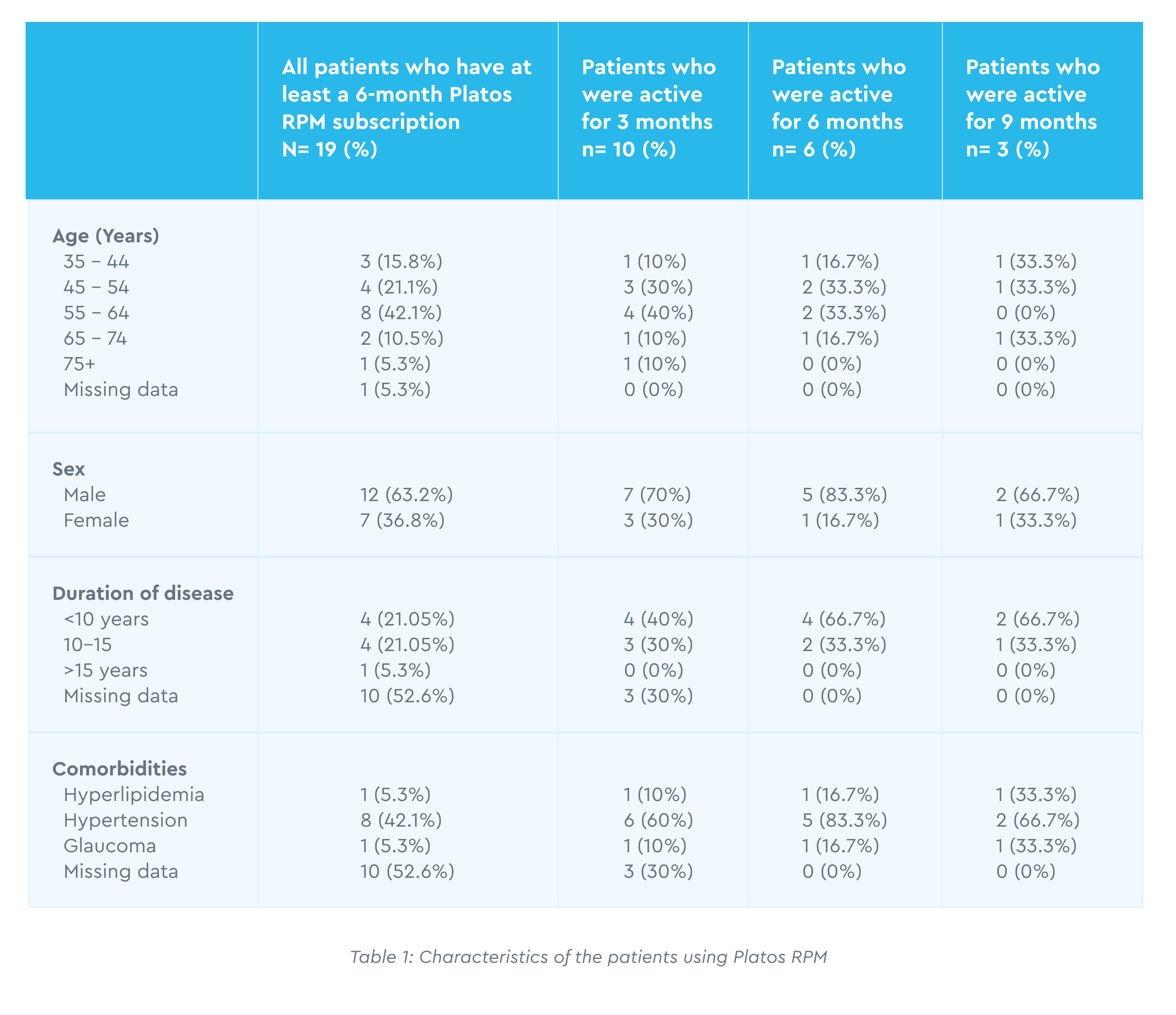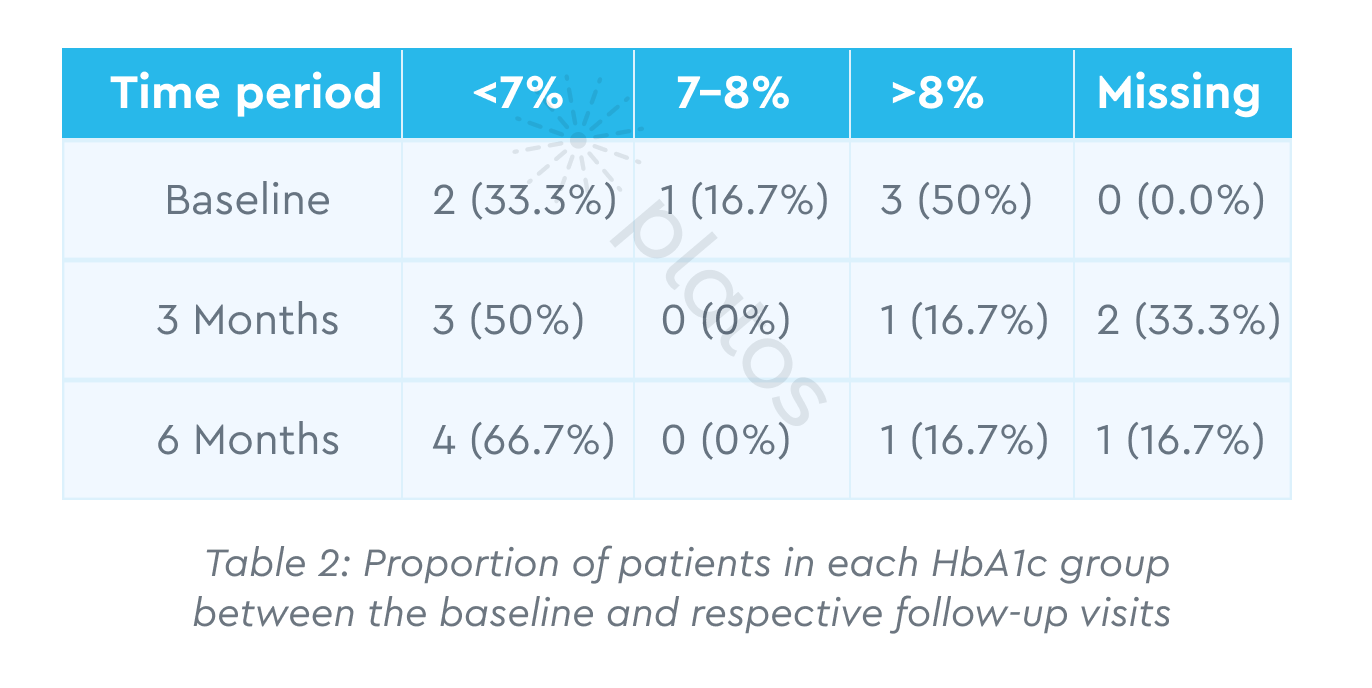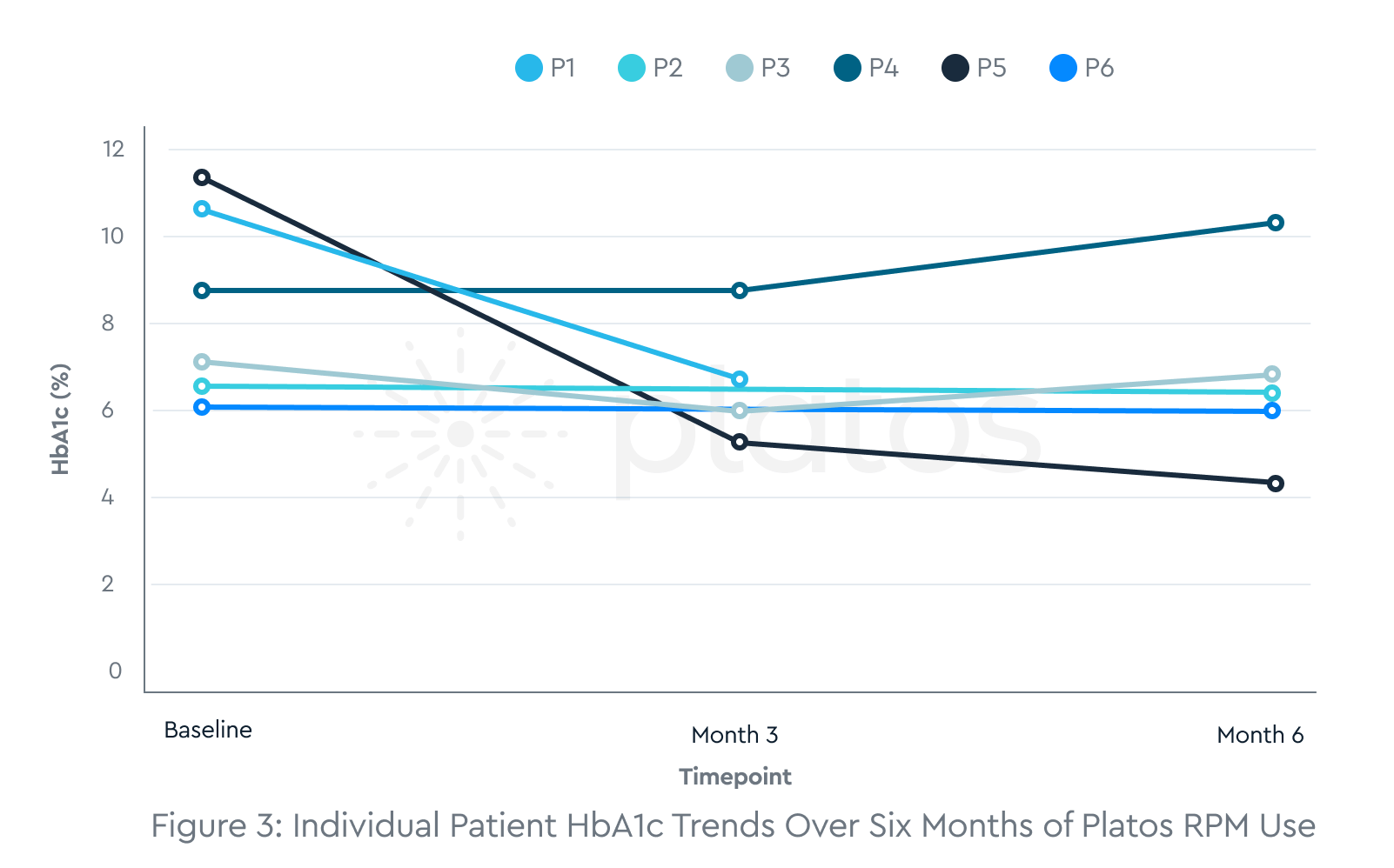Preliminary Evaluation of Platos Remote Patient Monitoring for Type 2 Diabetes Management among Chronicare Enrollees in Nigeria: A Retrospective Cohort Study with Exploratory User Insights

Principal Investigator: Dr Itopa Jimoh, MBBS, MPH, DrPH
Co-Researcher: Rodhiyat Raheem, B.Pharm
Background: Remote Patient Monitoring (RPM) has the potential to improve glycemic control by facilitating continuous tracking and timely provider feedback, yet evidence from low- and middle-income countries is limited.
Objective: To evaluate changes in HbA1c among patients enrolled in Platos RPM for at least six months and explore user experiences with the platform.
Methods: A retrospective cohort study was conducted using de-identified medical records of adults with type 2 diabetes mellitus (T2DM) enrolled in Platos RPM between January 2024 and September 2025. HbA1c was collected at baseline, 3 months, and 6 months. An exploratory survey was administered to two users to capture perceptions, perceived benefits, and challenges. Quantitative data were analyzed descriptively, and qualitative responses were summarized thematically.
Results: Of 22 enrolled patients, six remained active for at least six months with available HbA1c data. The proportion achieving HbA1c <7% increased from 33.3% at baseline to 66.7% at six months, while poorly controlled patients (HbA1c >8%) decreased from 50% to 16.7%. Both survey respondents reported high satisfaction with Platos RPM, increased confidence in self-management, and improved monitoring habits. Challenges were minimal, primarily occasional connectivity issues. Notably, one patient with multiple comorbidities and possible renal impairment did not improve, highlighting the need for tailored support in complex cases.
Conclusions: Platos RPM may improve glycemic control and patient self-efficacy in resource-constrained settings. Preliminary findings suggest that promoting consistent recording of multiple glucose parameters, encouraging patient logging, and proactive follow-up for high-risk patients could enhance RPM effectiveness. Larger, prospective studies are warranted to confirm clinical benefits and optimize implementation.
Introduction
Diabetes is a major global health challenge, contributing significantly to morbidity and mortality. In 2021, the International Diabetes Federation (IDF) estimated that 537 million adults worldwide had diabetes, a number projected to reach 783 million by 2045 (1). The burden is particularly high in low- and middle-income countries, where healthcare resources are often limited. Africa has seen a sharp rise in diabetes cases, with 24 million people affected in 2021 and projections reaching 55 million by 2045. As Africa’s most populous country, Nigeria carries a significant share of this burden, with 3.6 million adults living with diabetes, a number expected to rise to 4.9 million by 2030 (2).
Poor glycemic control is widespread among Nigerians with diabetes, increasing the risk of severe complications that reduce the quality of life, increase healthcare costs, reduce productivity, and negatively impact economic outcomes for both individuals and the nation. A study conducted between 2003 and 2012 found that mean HbA1c levels among Nigerian diabetes patients ranged from 8.1% to 8.3%, highlighting persistent challenges in maintaining good glycemic control (3). Limited access to diabetes care providers is a key contributor to poor glycemic control, a problem further worsened by the ongoing brain drain, which has significantly strained the healthcare sector.
Given these challenges, innovative approaches are needed to bridge gaps in diabetes care and improve disease management. One promising solution is Remote Patient Monitoring (RPM), which enables real-time tracking of health metrics, facilitates early intervention and enhances patient engagement. Despite its potential, RPM remains underutilized in Nigeria, and its impact on diabetes management within the local healthcare system remains largely unexplored.
Platos enables remote patient monitoring by allowing patients to securely share health data with their providers for timely treatment adjustments. The app integrates with smart devices, such as glucometers and body composition monitors, to track biomarkers including blood glucose, body fat, and weight. Abnormal readings trigger alerts to both patients and providers.
For diabetes management, Platos provides personalized insights by generating trends, charts, and summaries of each patient’s data, helping both patients and providers identify patterns and understand their health status over time. Real-time assistance includes in-app messaging for patient concerns, symptom assessments, and guidance during hypoglycemia or hyperglycemia events, such as advising hospital visits. These features enable continuous monitoring, timely provider response, and enhanced patient engagement.
Objective:
This study aimed to characterize patients enrolled in the Platos Remote Patient Monitoring (RPM) program for type 2 diabetes, to evaluate changes in HbA1c among those who maintained participation for at least six months, and to explore patient experiences with the program. Specifically, the study sought to understand patients’ perceptions of the benefits and challenges of using Platos RPM, their expectations for remote monitoring, and how these qualitative insights contextualize observed quantitative trends.
Methods
Study Design and Setting
A retrospective cohort study was conducted using de-identified electronic medical records from adults with T2DM enrolled in Platos RPM between January 2024 and October 2025. RPM enabled continuous glucose tracking, alerts for abnormal readings, symptom assessment, and provider feedback.
Participants
A total of 22 adults with type 2 diabetes receiving care at Chronicare Hospital were enrolled in the Platos RPM program between January 2024 and October 2025. Enrollment was voluntary, and only patients who expressed interest were invited to participate. Of these, 19 patients maintained a subscription for at least six months. However, only six patients consistently used the RPM during this period and were included in the study cohort for quantitative analyses.
Eligibility criteria for inclusion in the study cohort were: age ≥18 years, diagnosis of type 2 diabetes, consistent use of Platos RPM for at least six months, and availability of baseline HbA1c data. Demographic and clinical characteristics collected included age, sex, duration of diabetes, and comorbidities.
Qualitative Component
An exploratory qualitative survey was conducted to capture patient experiences with Platos RPM. The original plan was to include at least 10 participants; however, only two patients responded, both of whom had used the RPM consistently for at least six months. The participants opted for a semi-structured survey format instead of key informant interviews. Open-ended questions explored perceived benefits, challenges, and satisfaction with the RPM program. Responses were summarized descriptively and analyzed thematically to identify common themes, providing contextual insights to complement the quantitative findings.
Data Analysis
Quantitative analyses were descriptive due to the small sample. HbA1c values were summarized by baseline, 3 months, and 6 months. Proportions of patients achieving glycemic targets (<7%, 7–8%, >8%) were calculated. Qualitative responses were summarized thematically to highlight perceived value, barriers, and areas for improvement.
Results
Table 1 below shows the characteristics of the patients who were subscribed to Platos RPM for at least 6 months. Most patients were aged 45–64 years, and males constituted the majority (63.2%) of users. The largest fraction of patients had a disease duration of less than 10 years (21.1%) or 10–15 years (21.1%), with over half of the cohort missing duration data. Hypertension was the most commonly reported comorbidity (42.1%), followed by hyperlipidemia and glaucoma (5.3% each). Retention trends were similar across age and sex, with males representing 83.3% of patients active at 6 months.

HbA1c Outcomes
Table 2 shows the distribution of patients across HbA1c categories over six months.
At baseline, 2 patients (33.3%) had good glycemic control (HbA1c <7%), 1 patient (16.7%) had fair control (7–8%), and 3 patients (50%) had poor control (>8%). By three months, 3 patients (50%) had achieved HbA1c <7%, 1 patient (16.7%) remained poorly controlled, and 2 patients (33.3%) had missing data. At six months, 4 patients (66.7%) achieved HbA1c <7%, 1 patient (16.7%) remained in the poor control range, and 1 patient (16.7%) had missing data.
The patient who did not achieve good glycemic control was a 60-year-old male with multiple comorbidities, including hypertension and a prior stroke. Recent kidney function tests suggested possible renal impairment, and his BMI was 16 kg/m². His HbA1c remained unchanged at month three and worsened by six months. Review of his glucose logs on the Platos app showed persistently high random blood sugar (RBS) readings until month four, when he stopped recording them, whereas fasting blood glucose (FBG) measurements from month five were inconsistently recorded and did not reflect the same degree of hyperglycemia as the RBS readings.
Overall, these results indicate a progressive improvement in glycemic control among consistent RPM users, with the proportion achieving HbA1c <7% increasing from 33.3% at baseline to 66.7% at six months.


Qualitative Findings
Two participants who had used Platos RPM for at least six months completed the survey. While the small number of responses limits generalizability, their feedback provides contextual insights into user experience and perceived benefits of the platform.
Perceived Benefits and Satisfaction:
Both participants reported the highest level of satisfaction on the 5-point scale (“very satisfied”), indicating a positive perception of the app. Both respondents also indicated that the app was easy to use and convenient for accessing and tracking their readings.
Impact on Self-Management and Confidence:
Participants reported increased confidence in managing their blood sugar compared to before using the app. The responses suggested that RPM facilitated better self-monitoring habits and greater awareness of glycemic trends.
Challenges and Technical Issues:
One participant reported occasional connectivity issues. No other significant challenges or confusing features were noted.
Suggestions for Improvement:
Participants did not indicate major changes, though one suggested improving connectivity reliability to enhance the experience.
Strengths and Limitations of Data Collection:
While the survey provided useful descriptive insights into user experience, the information was limited in depth because probing questions could not be asked. Despite this limitation, the responses captured key aspects of usability, engagement, and perceived impact, which provide contextual support for the quantitative findings.
Discussion
This retrospective cohort study evaluated changes in glycated hemoglobin (HbA1c) among adults with type 2 diabetes mellitus (T2DM) enrolled in Platos’ Remote Patient Monitoring (RPM) program over six months. The results demonstrate a progressive improvement in glycemic control, suggesting that the use of RPM may enhance diabetes management outcomes in routine care.
At baseline, 2 out of 6 patients had achieved the recommended HbA1c target of <7%, while 3 patients had HbA1c levels >8%, indicating poor glycemic control. By the third month, 3 patients had achieved HbA1c <7%, and this increased to 4 patients by the sixth month. The number of patients with poorly controlled HbA1c (>8%) decreased from 3 at baseline to 1 at both follow-up points. Although HbA1c data were missing for 2 patients at month 3 and 1 patient at month 6, the overall trend demonstrates a clinically meaningful improvement in glycemic outcomes.
Improvement in HbA1c levels, even by a small margin, is clinically significant and is linked to reduced microvascular and macrovascular risks. For instance, a recent large study demonstrated that intensive glucose lowering was significantly associated with reduced microvascular events and nonfatal myocardial infarctions (5). Moreover, a meta-analysis has shown that targeting HbA1c levels in the range of 7.1–7.7% leads to substantial reductions in outcomes such as retinopathy and macroalbuminuria (6). The 2022 ADA Standards further affirm that achieving HbA1c levels around <7% is beneficial in reducing microvascular complications when it can be done safely (7).
The findings align with existing literature on the effectiveness of remote and digital health interventions for diabetes management. Systematic reviews and meta-analyses have demonstrated that remote patient monitoring can significantly improve HbA1c outcomes compared with usual care (8–10). RPM facilitates continuous glucose tracking, timely provider feedback, and improved adherence to treatment recommendations, mechanisms that may explain the positive outcomes observed in this study.
The experience of one patient who did not achieve improvement highlights that RPM effectiveness may vary in individuals with complex clinical profiles. This 60-year-old male had multiple comorbidities, including hypertension, prior stroke, impaired renal function, and low BMI. Despite engagement with Platos RPM, his HbA1c remained high at three months and worsened by six months. Glucose log review indicated that random blood sugar (RBS) readings, which had been persistently elevated, were consistently recorded only until month four, whereas fasting blood glucose (FBG) entries from month five onward were infrequent and did not reflect hyperglycemic spikes. The discontinuation of regular RBS monitoring, combined with limited FBG entries, likely contributed to the underestimation of his worsening glycemic status and delayed timely intervention. These observations suggest that, for high-risk patients, monitoring both RBS and FBG consistently with proactive clinical follow-up may be necessary to optimize RPM effectiveness.
The exploratory qualitative survey, although limited to 2 respondents and collected via self-administered questions, provided contextual insights into patient experience. Both participants reported very high satisfaction on the 5-point scale, convenience, and increased confidence in self-management, aligning with evidence from other studies showing that digital self-monitoring tools can improve self-efficacy and treatment adherence in diabetes management (10). The self-administered format limited depth, as probing follow-up questions were not possible, but the responses nonetheless support the acceptability and perceived value of RPM in resource-limited settings.
Other limitations include the small sample size, the missing data at follow-up which limits the statistical power and generalizability of the results. Additionally, potential confounders, such as changes in medication, diet, or physical activity, were not controlled for. Therefore, the findings should be interpreted as indicative rather than conclusive. Nevertheless, the direction and consistency of HbA1c improvement across follow-up periods support the potential value of remote diabetes monitoring programs like Platos RPM, particularly in contexts where access to specialist diabetes care is limited.
In conclusion, this study provides preliminary evidence that Platos’ Remote Patient Monitoring system may contribute to improved glycemic control among adults with T2DM. Future studies with larger sample sizes, longer follow-up, and adjustment for potential confounders are warranted to confirm these findings and better understand the pathways through which digital interventions can improve diabetes outcomes in real-world settings.
Strengths and Weaknesses:
Strengths:
- Mixed-methods design: Combining quantitative HbA1c analysis with qualitative patient feedback provides a more comprehensive understanding of Platos RPM’s impact.
- Patient-centered insights: Survey responses, though limited, capture user experiences, perceived benefits, and challenges, offering valuable context for quantitative trends.
- Real-world evidence: Data are drawn from routine clinical use of Platos RPM, reflecting actual patient engagement and outcomes in a Nigerian setting.
- Preliminary evidence for feasibility: The study demonstrates the potential for RPM to improve glycemic control and patient self-efficacy in a resource-limited context.
Weaknesses:
- Small sample size: Only six patients had complete HbA1c data, and two completed the qualitative survey, limiting statistical power and generalizability.
- Incomplete data: Missing measurements at 3 and 6 months reduce the robustness of trend analysis and prevent formal statistical inference.
- Limited qualitative depth: Only two patient responses were collected, and it relied on self-administered surveys, and planned Key Informant Interviews (KIIs) could not be conducted. This limited the ability to probe responses and fully understand broader user experiences, barriers, and contextual factors.
- Descriptive analysis only: The study was exploratory and hypothesis-generating, precluding causal conclusions.
Conclusion and Recommendations:
The use of Platos Remote Patient Monitoring (RPM) in this small cohort of adults with type 2 diabetes in Nigeria appeared to support the management of glycemic control, as indicated by improvements in HbA1c over six months among consistent users. Integration of RPM into routine diabetes care may help patients monitor their health data more effectively and increase confidence and engagement in self-management, as suggested by the exploratory qualitative feedback.
While RPM was effective for most participants, the experience of one patient who did not achieve improvement highlights that additional tailored support may be beneficial for individuals with complex clinical profiles. Such enhancements could include consistent logging of both fasting and random blood glucose, and proactive clinical follow-up for high-risk patients, to further enhance the effectiveness of RPM in these cases.
While limited by sample size, missing data, and the descriptive nature of the study, these findings provide preliminary evidence that RPM can be a feasible tool to complement standard diabetes care in resource-constrained settings. Future studies with larger cohorts, longer follow-up, and consideration of patient complexity and monitoring adherence are warranted to evaluate the broader applicability and potential impact of RPM on clinical outcomes.
References:
- World Health Organization (WHO). Diabetes, key facts. September 2022. Available from: https://www.who.int/news-room/fact-sheets/detail/diabetes
- International Diabetes Federation. Diabetes in Africa. IDF Diabetes Atlas, 10th edition; 2021. Available from: https://www.diabetesatlas.org
- Sobngwi E, Ndour-Mbaye M, Boateng KA, et al. Type 2 diabetes control and complications in specialized diabetes care centers of sub-Saharan Africa: The DiabCare Africa study. Ethn Dis. 2014;24(4):502–509. Available from: https://ethndis.org/archive/files/ethndis-24-502.pdf
- Løvaas KF, Cooper JG, Sandberg S, Røraas T, Thue G. Feasibility of using self-reported patient data in a national diabetes register. BMC Health Serv Res. 2015;15:1–7.
- Kunutsor SK, et al. Glycaemic control and macrovascular and microvascular outcomes in type 2 diabetes: A systematic review and meta-analysis of trials investigating intensive glucose-lowering strategies. Diabetes Obes Metab. 2024;26(3):530–542. doi:10.1111/dom.15511
- Sinha B, et al. A target HbA1c between 7 and 7.7% reduces macrovascular and microvascular events in type 2 diabetes regardless of duration: A meta-analysis of randomized controlled trials. Diabetes Obes Metab. 2021;23(4):1012–1021. doi:10.1111/dom.14262
- ElSayed NA, et al. Glycemic Targets: Standards of Medical Care in Diabetes—2023. Diabetes Care. 2023;46(Suppl 1):S97–S112. doi:10.2337/dc23-S006
- Lee PA, Greenfield G, Pappas Y. The impact of telehealth remote patient monitoring on glycemic control in type 2 diabetes: a systematic review and meta-analysis of systematic reviews of randomised controlled trials. BMC Health Serv Res. 2018;18:495
- Kebede MM, Zeeb H, Peters M, Heise TL, Pischke CR. Effectiveness of digital interventions for improving glycemic control in persons with poorly controlled type 2 diabetes: A systematic review, meta-analysis, and meta-regression analysis. Diabetes Technol Ther. 2018;20(11):767–782. doi:10.1089/dia.2018.0216
- Greenwood DA, Gee PM, Fatkin KJ, Peeples M. A systematic review of reviews evaluating technology-enabled diabetes self-management education and support. J Diabetes Sci Technol. 2017;11(5):1015–1027.